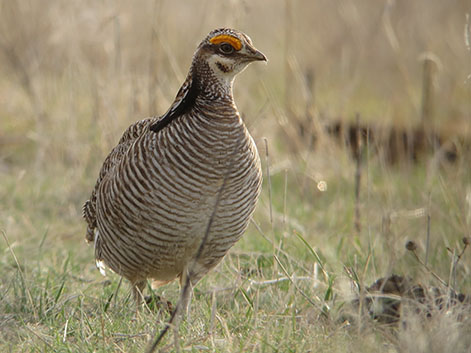Lesser Prairie-Chicken Habitat Selection Based on Prescribed Fire, Microclimate, and Vegetation Characteristics
 Investigators:
Investigators:
Jonathan Lautenbach, M.S. Student
Project Supervisor:
Dr. David Haukos
Funding:
Natural Resources Conservation Service
Kansas Department of Wildlife, Parks, and Tourism
Cooperators:
Kansas Department of Wildlife, Parks, and Tourism
Natural Resources Conservation Service
Kansas State University
U.S. Fish and Wildlife Service
Location:
Kansas
Completion:
March 2017
Status:
Completed
Objectives:
- Assess the response of lesser prairie-chickens to prescribed fire.
- Characterize vegetation comprising lesser prairie-chicken habitat across the species' range in Kansas.
- Determine the role of microclimate for fine scale habitat selection by lesser prairie-chickens.
Progress and Results:
The lesser prairie-chicken is a prairie grouse native to the southwestern Great Plains that has experienced significant population and habitat declines since European settlement. Ongoing declines prompted the U.S. Fish and Wildlife Service to list lesser prairie-chickens as threatened under the Endangered Species Act in spring of 2014. In fall of 2015, the listing was vacated on procedural grounds and the lesser prairie-chicken was removed from listing in summer 2016. Despite the legislative change, considerable conservation efforts emerged with the initial listing and have continued following the removal of the species from the threatened and endangered species list. Understanding how lesser prairie-chickens use landscapes and how management actions can influence their space use is important for long-term strategies to meet conservation goals. I modeled lesser prairie-chicken habitat selection relative to landscape mosaics of vegetation patches generated through patch-burn grazing, microclimate, and vegetation characteristics across their range. I captured, attached GPS satellite or VHF radio transmitters to, tracked, and measured vegetation characteristics used by and available to female lesser prairie-chickens across the northern portion of their range in Kansas and Colorado. Female lesser prairie-chickens use all patch types created in a patch-burn grazing mosaic, with female selecting greater time-since-fire patches (>2-years post-fire) for nesting, 2-year post-fire patches during the spring lekking season, 1- and 2-year post-fire patches during the summer brooding period, and 1-year post-fire units during the nonbreeding season. Available vegetation structure and composition in selected patches during each life-cycle stage was similar to the needs of female lesser prairie-chickens during that life-cycle stage. To assess their selected microclimate conditions, I deployed Maxim Integrated Semiconductor data loggers (iButtons) at female flush locations and across a landscape inhabited by lesser prairie-chickens. Females selected locations that minimized thermal stress at microsite, patch, and landscape scales during peak midday temperatures during summer. Females selected midday locations based on vegetation characteristics; where selected sites had >60% forb cover and <25% grass cover, or >75% grass cover and <10% forb cover. In addition, females selected sites with greater visual obstruction. I measured vegetation composition and structure at use and available sites at four study areas located along the precipitation gradient characterizing the full extent of the lesser prairie-chicken range. Vegetation structure use by females varied in relation to long-term precipitation patterns. Females used sites with lower visual obstruction than available during the fall and spring. However, they used vegetation composition that was similar to available within each study area. Overall, my findings indicate that lesser prairie-chickens require structural and compositional heterogeneity to support a suite of habitat needs throughout the year. Therefore, management should focus on providing structural and compositional heterogeneity across landscapes. Greater heterogeneity in vegetation conditions can be achieved through management practices that allow domestic grazers to select grazing locations, such as patch-burn grazing or increased pasture area.
Products:
Thesis:
Lautenbach, Jonathan (M.S., 2017; advisor Haukos) The role of fire, microclimate, and vegetation in lesser prairie-chicken habitat selection. Master's Thesis, Division of Biology, Kansas State University.
Professional Presentations:
Lautenbach, J. D., D. A. Haukos and B. A. Grisham. 2017. Lesser Prairie-Chicken Habitat Selection during Extreme Temperature Events. The Wildlife Society 24th Annual Conference, Albuquerque, NM.
Lautenbach, J. D., D. A. Haukos, and B. A. Grisham. 2017. Fried Chicken: Identifying Areas of Thermal Refugia for Lesser Prairie-Chickens in a Changing Climate. Midwest Fish and Wildlife Conference, Lincoln, NE.
Lautenbach, Jonathan. 2017. Quantifying Landscape and Vegetative Characteristics of Lesser Prairie-Chicken Habitat during Extreme Temperature Events. Society for Range Management Meeting in St. George, UT.
Lautenbach, J., D. A. Haukos, and C. Hagen. 2016. Satisfying the Quilt Work of Habitat Needs of the Lesser Prairie-Chicken: The Role of Patch-Burn Grazing. The Wildlife Society 23rd Annual Conference, Raleigh, NC.
Lautenbach, J. 2016. Using patch-burn grazing to maintaining prairie for lesser prairie-chickens. Division of Biology, Graduate Student Forum, Kansas State University
Lautenbach, J.D., J.M. Lautenbach, D.A. Haukos, R.T. Plumb, J.C. Pitman, and C.A. Hagen. 2016. Using Patch-burn Grazing to Maintain Prairie for Lesser Prairie-Chickens. Kansas Natural Resources Conference, Wichita, KS.
Lautenbach, J.D., J.M. Lautenbach, D.A. Haukos, R.T. Plumb, J.C. Pitman, and C.A. Hagen. 2016. Killing Trees and Maintaining Prairie for Lesser Prairie-Chickens through Patch-Burn Grazing. Society for Range Management Annual Meeting, Corpus Christi, TX.
Lautenbach, J.D., and D. A. Haukos. 2016. Response of Lesser Prairie-Chicken Habitat and Habitat Use to Patch-Burn Grazing. Midwest Fish and Wildlife Conference, Grand Rapids, MI
Lautenbach, J.D., J.M. Lautenbach and D.A. Haukos. 2015. Effect of Patch-Burn Grazing on Vegetation Composition in the Eastern Portion of the Lesser Prairie-chicken Range. Biennial meeting of the Prairie Grouse Technical Council, Nevada, Missouri.